As usual, one of the best sources of information is the Kyoto Costume Museum. If you go there, check the Japanese language pages too, they have a lot of information that hasn't been translated to English. In Japanese, the costumes section starts here: http://www.iz2.or.jp/fukushoku/f_disp.php?page_no=0000001. In English, it's here: http://www.iz2.or.jp/english/index.htm. (Tip: Google Translate won't really make much sense, but will at least allow you to locate the period names in the menu!)
One problem with the English side of the Kyoto Costume Museum website is that they lump everything post-Heian and pre-Edo together into one huge Kamakura period, which covers more than 400 years of costume history. Digging through the Japanese side of the site, I found that they divide this period in three eras:
- Kamakura (1185–1333)
- Muromachi (1336-1573)
- Azuchi-Momoyama (1573-1603)
The first image is from the Kamakura period (1185–1333). This is too early for me, but it's closer to what would be found in Momoyama than Heian or Edo period.
| A woman in everyday wear, kosode and yumaki (=light wrapping skirt). Found here: http://www.iz2.or.jp/english/fukusyoku/busou/8.htm. There is not much to say about it. Ankle-length kosode, apron-like cloth at the waist, long hair, long sleeves (they seem longer than modern kimono sleeves). It doesn't seem to be puffed up at the waist, but seems to be cut ankle-length, which is good for me. | 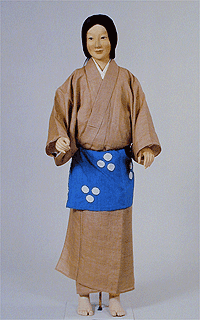 |
These are from the Muromachi era (1336–1573). Getting closer to the dates I'm aiming for. There were a few pictures of commoners in that era.
| Ohara-me or peasant woman of Ohara village selling firewood in Kyoto, from this address http://www.iz2.or.jp/english/fukusyoku/busou/24.htm. This is a little earlier than I'd like, but it would be much more practical than a long kimono for working in the kitchen (or running around in the woods, for that matter!). White socks in sandals in the dust and grit outside, though, will not stay white long! But see the next example for a solution. Note that she is also wearing an apron, even if we can't see this in the picture. | |
| Katsura-me or peasant woman of Katsura village selling food in Kyoto, from this address http://www.iz2.or.jp/english/fukusyoku/busou/25.htm. Much like the other one, except yay, no socks! The head covering would be practical for cooking too. I love the dye job on this, and reproducing it would be feasible. | |
| Woman of the warrior class in street wear: a kosode pulled up over her head. It's on this page: http://www.iz2.or.jp/english/fukusyoku/busou/23.htm. What interests me most is twofold. First, the obi is not really an obi at all, and tied in front. This is normal for the period. Second, the kosode seems to be made ankle-length, not longer and folded over like it's done on court ladies or in post-Edo kimonos. Also, she doesn't seem to be wearing tabi. And, the pattern on her kosode is very interesting, because it's not an all-over pattern like in earlier eras. They call it the tsuji-ga-hana zome dyeing method. Basically, it is tie-dyeing (shibori), but supplemented with many different methods (painting, embroidery, etc.) | 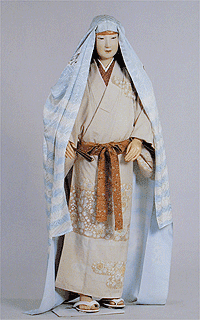 |
The other interesting ones I found are all in the Edo period. This period starts in 1603, which would be perfect for me, if I knew which costumes correspond to what date on the Costume Museum site. But since it goes up until 1868, it ends up wayyy out of my timeframe. While clothing didn't undergo any major changes between Heian and Edo, it changed dramatically during the Edo period to become standardized into what we now know as traditional Japanese costume. So using anything from that era is risky.
In any case, here are the two interesting costumes I found. (There's another one, but it's described as late-Edo, so I won't include it here.)
| Commoner in Kosode (short-sleeved kimono) of the early Edo era. http://www.iz2.or.jp/english/fukusyoku/kosode/3.htm. The explanations on the website for this one are interesting. The sleeves become shorter and the obi wider (and it's now worn in the back); the fabric width becomes standardized; and she's wearing coloured tabi. Also, the pattern is printed on the kimono, not woven. | |
| Commoner in kosode (short-sleeved kimono) of Genroku (1688-1704) or the (yes, it ends like that on the site). Found at this address http://www.iz2.or.jp/english/fukusyoku/kosode/4.htm. It's later than my period, but it looks more like the kimonos in Shogun than any other of earlier dates on the site. The description talks extensively about the resist dyeing techniques developed at the time, which means I probably can't use anything similar for my own kimono. This one might have the waist poofed up; there's no way to know under the obi. | 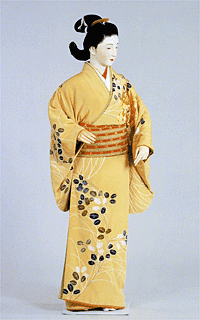 |
Questions:
How do I make the arm and leg coverings?
What is the standard width of fabric (if there is one) for a pre-Edo commoner?
How good/bad are the costumes in Shogun?
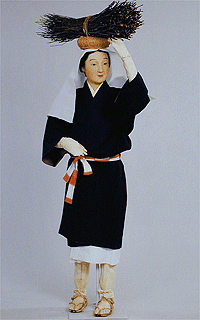
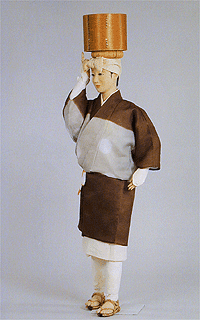
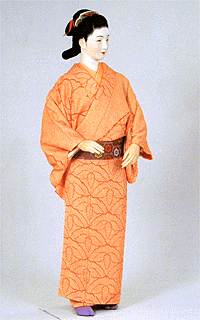



No comments:
Post a Comment